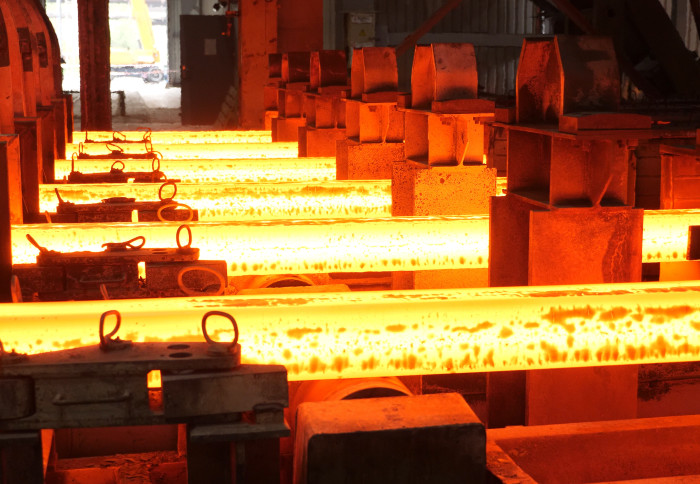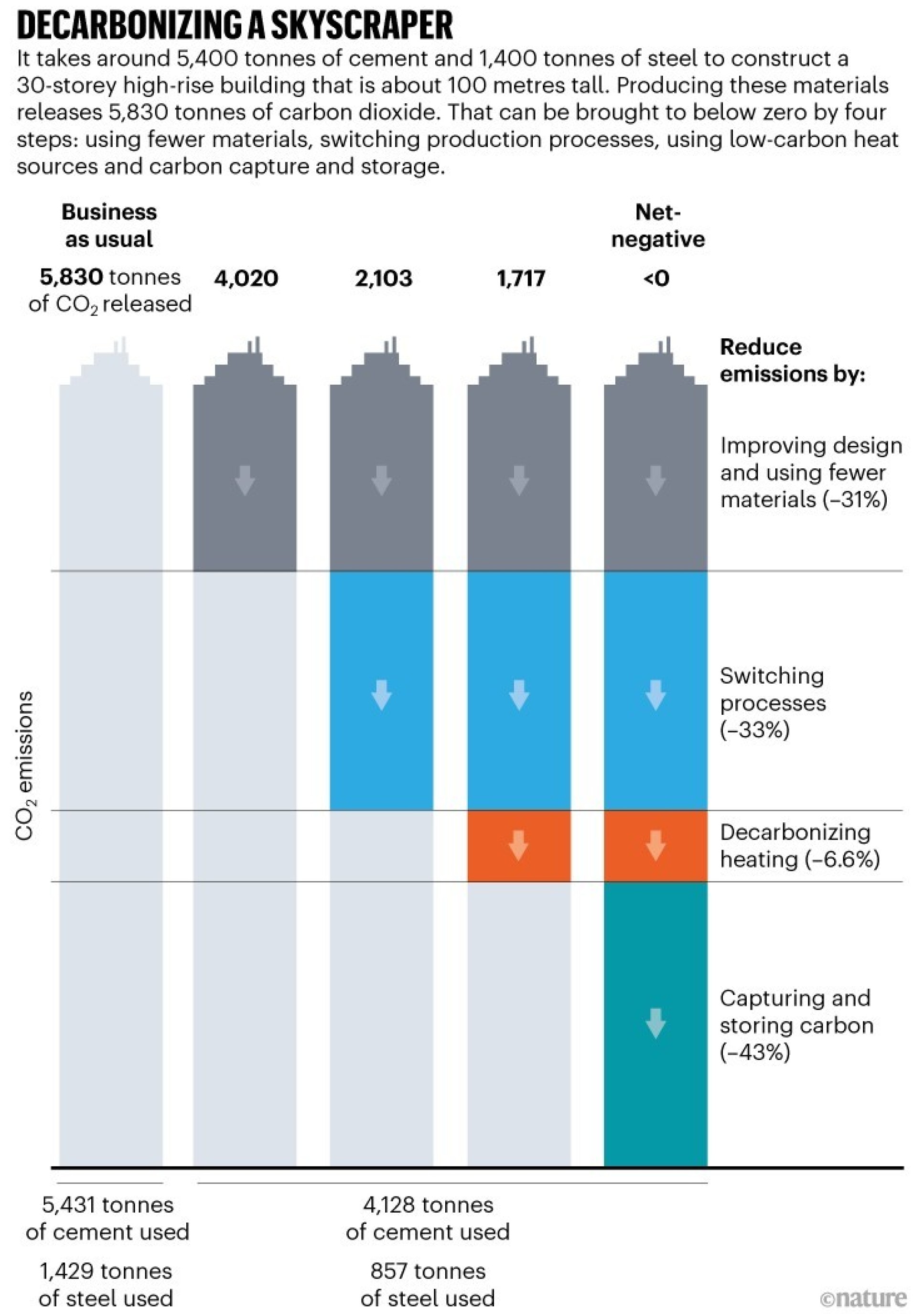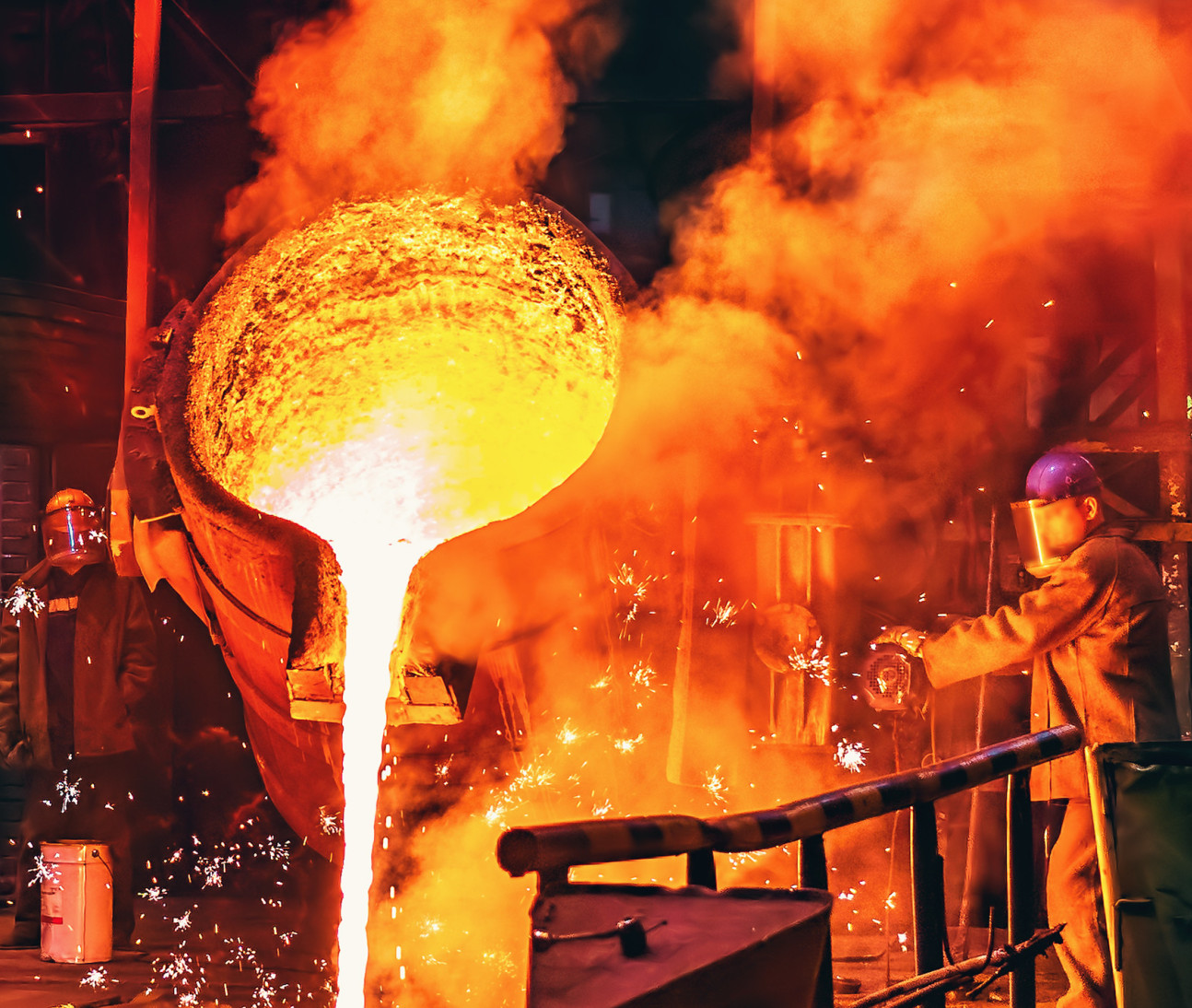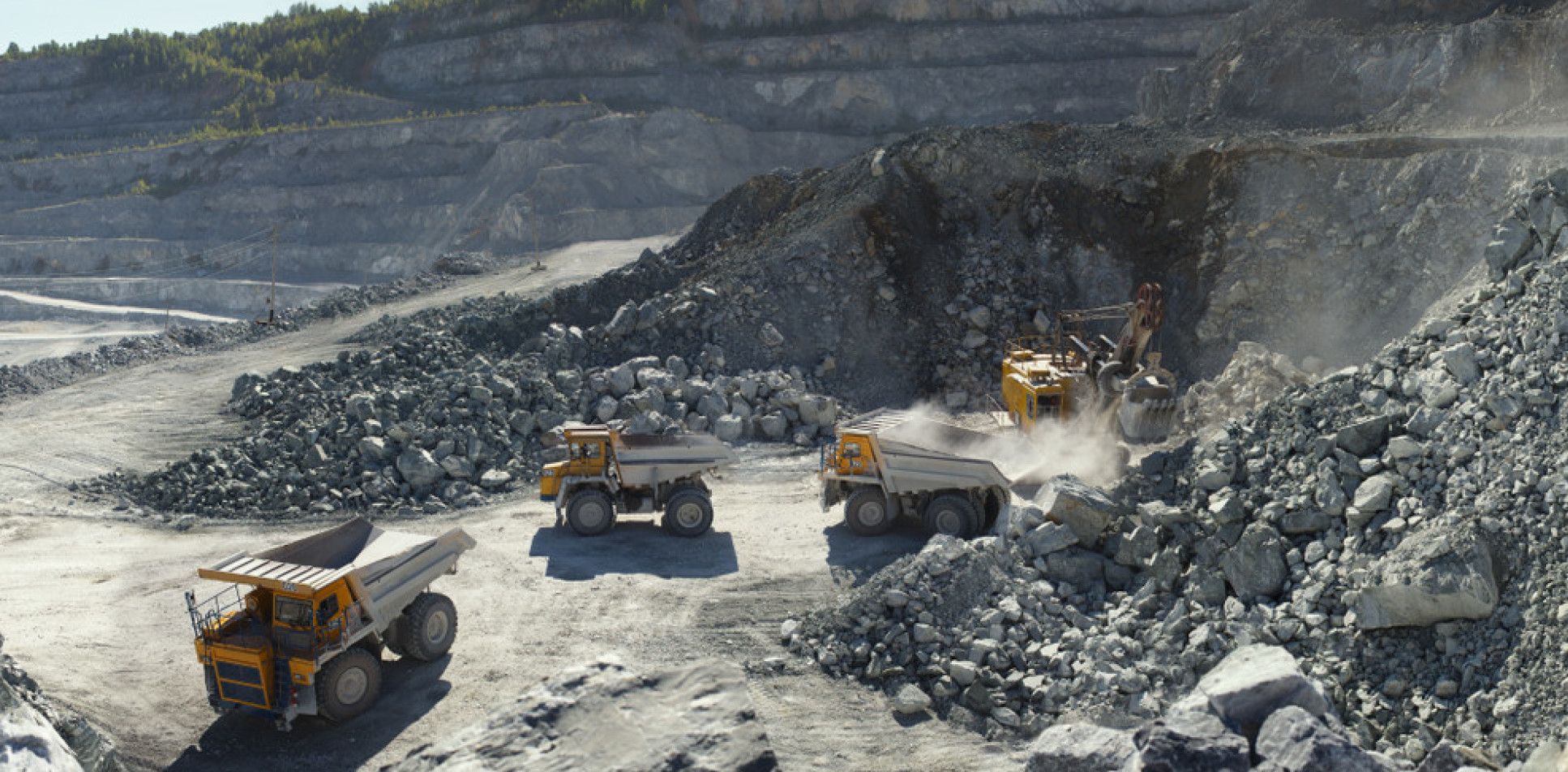‘Greening’ cement and steel: 9 ways these industries can reach net zero

Refining iron into steel emits 1,800kg CO2/tonne of steel
It is possible – and crucial – to help the building blocks of the modern world reach net zero, according to scientists writing in Nature.
Cement and steel are essential ingredients of buildings, cars, dams, bridges and skyscrapers, but the industries creating them are among the dirtiest on the planet. Cement and steel production contribute 6.5% (2.3 billion tonnes) and 7% (2.6 billion tonnes) of global CO2 emissions respectively.
We urgently need cleaner ways to make and use cement and steel...even as industrial demand grows and energy prices spike. Professor Paul Fennell Department of Chemical Engineering
That’s in part owing to the large quantities in which these materials are used: concrete is the second-most-consumed product on the planet, after clean water. It’s also thanks to their carbon-intensive manufacturing: the chemical reactions, and the burning of fossil fuels to deliver the extreme temperatures required, all release CO2.
Writing in Nature, a team of scientists, including Imperial College London’s Professor Paul Fennell and Dr Justin Driver, has highlighted nine priorities for research and action to take steel manufacturing close to being carbon neutral and the cement industry to becoming a carbon sink, including using fewer materials, switching production processes, using low-carbon heat sources and increasing carbon capture and storage capacity.
Professor Fennell of the Department of Chemical Engineering said: “We urgently need cleaner ways to make and use cement and steel. The world must reach net-zero carbon emissions by 2050, even as industrial demand grows and energy prices spike.”

1. Use the latest technologies
Fitting production plants with the best available technology offers immediate gains: Improving insulation of industrial plants can save 26% of the energy used, better boilers cut energy needs by up to 10%, and using heat exchangers can decrease the power demands of refining by 25%. However, gains diminish as industries mature: today, the most efficient cement plants can squeeze only 0.04% of energy savings per year by upgrading technologies. The researchers argue that more must be done to develop the appropriate technologies.
2. Use less
Small but significant changes to building codes and education for architects, engineers and contractors could reduce demand for cement by up to 26% and for steel by 24%, according to the International Energy Agency. However, many building codes rely on over-engineering for safety’s sake. That margin could be limited by using modern materials and computer modelling to use only the necessary amount of resource. Alternative materials with smaller lifecycle carbon footprints, like aluminium, might replace steel in some products, including cars.
3. Reinvent steel production
Carbon-heavy coke and coal are key to refining iron into steel – a process that emits 1,800 kilograms of CO2 per tonne of steel. However about 5% of the world’s steel is currently made through ‘direct reduced iron’ (DRI) processes that don’t require coke and typically use hydrogen and carbon monoxide, derived from methane or coal.
 Plants that use methane-derived gas and renewable electricity for DRI emit 61% less CO2 than coke-based ones. Better still, plants that use only hydrogen for DRI could reduce emissions by 97% to 50 kilograms or less per tonne of steel.
Plants that use methane-derived gas and renewable electricity for DRI emit 61% less CO2 than coke-based ones. Better still, plants that use only hydrogen for DRI could reduce emissions by 97% to 50 kilograms or less per tonne of steel.
Firms worldwide are piloting such hydrogen-based plants, with several slated to open by 2026. The challenge is that producing all steel this way would mean tripling global hydrogen production, which mostly comes from natural gas and releases CO2. A greener, but more expensive, way to produce hydrogen uses electrolysers to split water – however costs will come down as more plants are built.
4. Reinvent cement production
About 60% of emissions from a top-quality cement plant come from the calcination of limestone into lime, and most of the rest from burnt fuel. In total, the process produces about 800 kilograms of CO2 per tonne of cement in an average plant, and 600 kilograms in a best-in-class one.
One option is replacing some of the clinker – the combination of lime, sand and clay before it's mixed with other materials to create cement – with more sustainable materials like blast-furnace slag and ash from coal-fired power stations, but those materials will become scarce when fossil fuels are phased out.

One promising example is limestone calcined clay cement (LC3). With similar properties to ordinary Portland cement – the most common type of cement – it’s easy to switch to. Up to half of the clinker in it can be replaced, and some companies already include LC3 technology in their net-zero strategies.
5. Swap fuel
Steel
It is tempting to suggest replacing coal and coke with charcoal or other forms of biomass, but growing biomass for energy can conflict with agricultural land needs, and not all biomass is sustainable. The researchers argue that reinventing steel production is a better approach.
Cement
Municipal solid waste — or carefully sorted rubbish — can be used as an alternative fuel: high temperatures in the kiln incinerate toxic materials in the waste, and the ashes can be incorporated into clinker. This is already being implemented in plants around the world, and the researchers argue that this strategy be encouraged, including by passing appropriate regulations at a national level.
6. Capture and store released carbon
Carbon capture and storage (CCS) technology – capturing carbon from the atmosphere and storing it underground - is underused globally. Just 0.1% of all global emissions are currently captured and stored, and the researchers argue that CCS must be rapidly scaled up.
To address the billions of tonnes of CO2 released each year, steel manufacturing processes need a rethink, and cement’s biggest gains will require CCS Dr Justin Driver Department of Chemical Engineering
A major challenge is that the stream of CO2 needs to be more than 99.9% pure to reduce costs for compressing and storing the gas, whereas typical steel and cement plant flues consist of only 30% CO2.
One way to isolate CO2 from the calcination process is to heat the limestone through a wall so that emissions from heating are separated from those from the limestone. The emissions from limestone are nearly pure and don’t require much further processing, reducing the cost. Such projects are ongoing.
An additional option is building heavy industries in clusters to allow heat, materials and infrastructure for making and storing hydrogen, as well as collecting and disposing of waste CO2, to be shared. Such clusters are already being developed.
7. Store CO2 in concrete
Cement and concrete both absorb CO2 from the air. In theory, roughly half of the CO2 emissions from cement manufacturing could be re-absorbed, but the concrete particles would have to be ground up to make them smaller so that CO2 can diffuse in better. That’s expensive, and requires energy.
The researchers urge caution with this approach to avoid disincentivising CCS and more traceable means of reducing cement’s carbon footprint.
8. Recycle steel
Steel can be efficiently recycled, and one-quarter of steel production today is based on recycled scrap. Globally, recycling steel is expected to double by 2050, reducing emissions by 20–25% from today. However, it is not currently possible to recycle steel endlessly because undesirable compounds, like copper, build up. Their accrual can be slowed by better sorting scrap and by re-designing products so that copper is easier to remove.
9. Subsidise changes
Together, the potential of these eight steps is vast, but the approaches can be expensive. The researchers say these economic hurdles must be overcome if low-carbon industries are to reach the scale of production needed to reach net zero.
Scaling up facilities like hydrogen-only DRI plants for steel and CCS facilities for cement is expensive and financially risky, and low-carbon products lack competitive advantage and markets. Developing countries, where most construction is happening, need technology to be shared as well as mechanisms to lessen financial risks.

Conditional, scaled government subsidies — similar to feed-in tariffs, which incentivise investment in wind and solar technologies — would be more effective. These subsidies would need to match the losses felt by producers: for the EU, the researchers estimate that could cost up to $200 billion over 10 years.
Co-author Dr Justin Driver of Imperial’s Department of Chemical Engineering said: “To address the billions of tonnes of CO2 released each year, steel manufacturing processes need a rethink, and cement’s biggest gains will require CCS. With careful redesign, both industries will be massive contributors in our race to net zero.”
This story was adapted from a comment in Nature. Read the full report:
“Cement and steel — nine steps to net zero” by Paul Fennell, Justin Driver, Christopher Bataille and Steven J. Davis. Published 23 March 2022 in Nature.
'Decarbonizing a skyscraper' infographic: © Nature
Photographs: Shutterstock
Article text (excluding photos or graphics) © Imperial College London.
Photos and graphics subject to third party copyright used with permission or © Imperial College London.
Reporter
Caroline Brogan
Communications Division